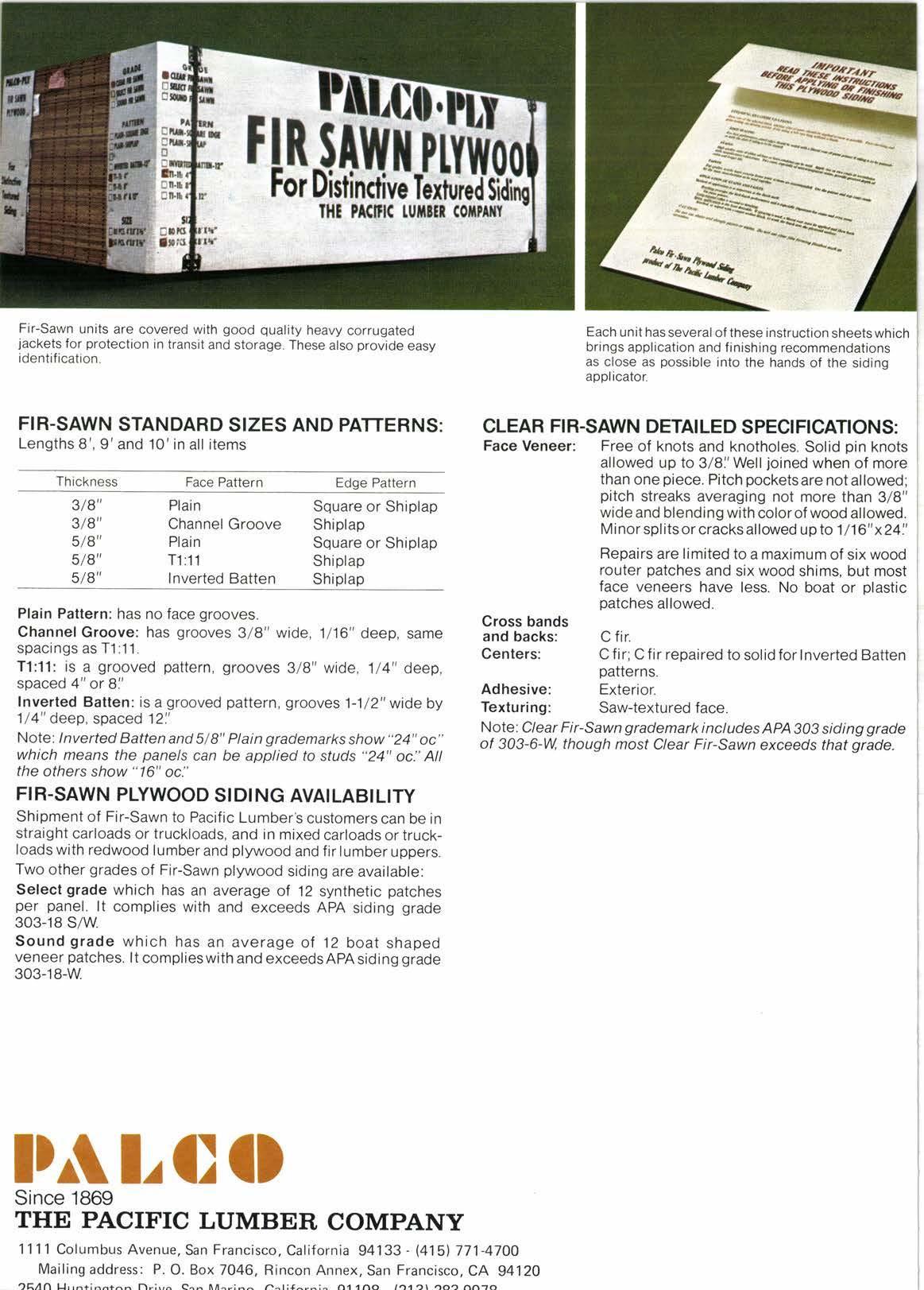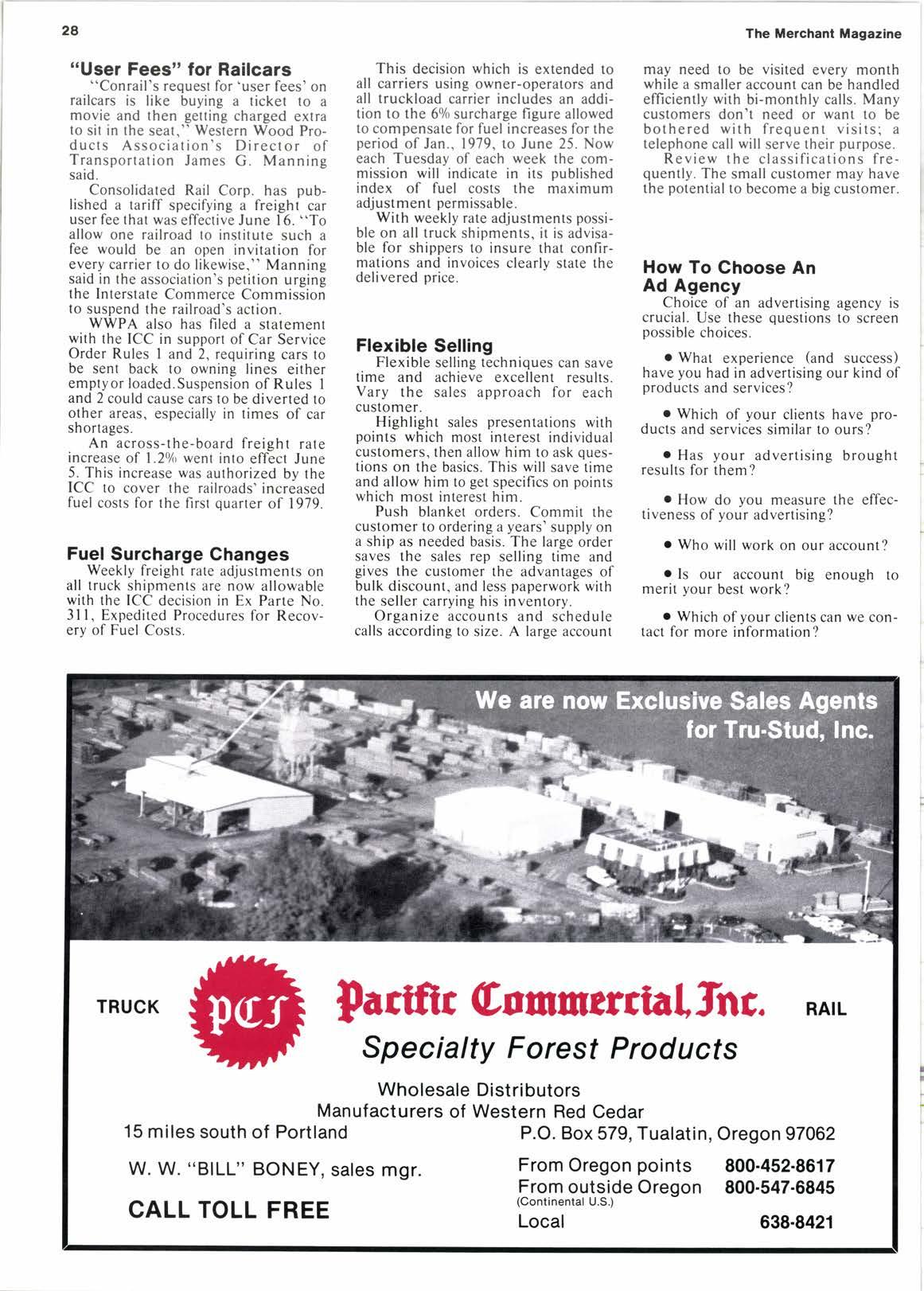
4 minute read
PACIFIC LUMBER COMPANY
Each unit has several of these instruction sheets which brings application and finishing recommendations as close as possible into the hands of the siding applicator.
CLEAR FIR.SAWN DETAI LED SPECIFICATIONS:
Face Veneer: Free of knots and knotholes. Solid pin knots allowed up to 3/81'Well joined when of more than one piece. Pitch pocketsare notallowed; pitch streaks averaging not more than 3/8" wideand blending with colorof wood allowed. Minor spf its or cracks allowed up to 1 / 16" x24!'
Repairs are limited to a maximum of six wood router patches and six wood shims, but most face veneers have less. No boat or olastic oatches allowed.
Cross bands and backs:
Centers:
Adhesive:
Texturing:
C fir.
C fir; C f ir repaired to solid for Inverted Batten oatterns.
Exterior.
Saw-textured face.
Note: C/ear Fl r-Sawn grademark includes APA303 siding grade ot 303-6-W, though most Clear Fir-Sawn exceeds that grade.
BUIIIILES of 1 x 2's which have been banded with Avistrapo polypropylene strapping are stacked in a compact load at Chandler Coro. Distribution Center. Next. two steel straps will be applied to hold the load together during shipment.
Bundled lumber development

The rapid growth of home centers and do-it-yourself building products outlets has led to new packag- ing requirements and new merchandising opportunities for lumber wholesalers.
Chandler Corporation's Wichita, Ks., Distribution Center purchases wide width lumber from its own plants and from various U.S. and Canadian lumber companies. The production operation consists of ripping the wide boards down to narrower finished widths, packaging and shipping them to a number of leading home center outlets.
Retail lumber outlets have found in-store merchandising is easier when small bundles of lumber can be displayed and sold individually. To meet this need, Chandler bands small bundles together with Avistrap@ plastic strapping. These bundles are then consolidated into a large unit load held together with two steel straps.
In the case of l" x 2" lumber for example, a unit load contains about 1,000 lengths. When the retail store cuts the steel straps, the load remains relatively organized, due to the smaller bundles, rather than gradually collapsing into a shambles.
Further, the strapping prevents random twisting which could otherwise deform the narrower sizes of lumber. And plastic strapping can be easily and safely removed by the consumer.
The operation has three stages. First, wide width boards are passed through a rip saw. A second operator receives the cut-to-width boards and stacks them on a roller top table, specially designed for Chandler by the Systems Engineering Div. of Carlson Stapler and Shippers Supply of Omaha, Nb. When the proper number of strips are accumulated. the stacker slides the pre-squared bundle onto a set of rollers and lightly pushes it towards an FMC strapping station. As the stack reaches the end of the roller table, a pneumatic press bar automatically contacts it and keeps it together as it approaches the strapping station.
At this point, the stack is picked up by an automatic in-feed/outfeed conveyor which is integrated with the circuitry of the automatic strapping machine.
As the conveyor moves the stack through the strapper, two bands of 3/8" width polypropylene strapping are automatically applied around the bundle at exact positions. After the second strap is tensioned and heat-sealed, the bundle is fed onto another conveyor table where a third operator stacks the bundles and unitizes the larger load with steel strapping. Unit loads are then shipped with other lumber products in truck load lots to Chandler customers.
"User Fees" for Railcars
"Conrail's request for 'user fees' on railcars is like buying a ticket to a movie and then gelting charged extra lo sit in the seat," Western Wood Products Association's Director of Transportation James G. Manning said.
Consolidated Rail Corp. has published a tariff specifying a freight car user fee that was effective June 16. "To allow one railroad to institute such a fee would be an open invitation for every carrier to do likewise," Manning said in the association's petition urging the Inlerstate Commerce Commission to suspend the railroad's action.

WWPA also has filed a statemenl with the ICC in support of Car Service Order Rules 1 and 2, requiring cars to be sent back to owning lines either emptyor loaded.Suspension of Rules I and 2 could cause cars to be diverled to olher areas, especially in times of car snortages.
An across-the-board freieht rate increase of l.2ol, went into effEct June 5. This increase was authorized bv the ICC to cover the railroads' increased fuel costs for the first quarter of 1979.
Fuel Surcharge Changes
Weekly freight rate adjustments on all truck shipments are now allowable with the ICC decision in Ex Parte No. 3ll, Expedited Procedures lor Recovery of Fuel Costs.
This decision which is extended to all carriers using owner-operators and all truckload carrier includes an addition to the 60/o surcharge figure allowed to compensate for fuel increases for the period ofJan., 1979, to June 25. Now each Tuesday of each week the commission will indicate in its published index of fuel costs the maximum adjustment permissable.
With weekly rate adjustments possible on all truck shipments, it is advisable for shippers to insure that confirmations and invoices clearlv state the delivered price.
Flexible Selling
Flexible selling techniques can save time and achieve excellent results. Vary the sales approach for each customer.
Highlight sales presentations with points which most interest individual customers, then allow him to ask questions on the basics. This will save time and allow him to get specifics on points which most interest him.
Push blanket orders. Commit the customer to ordering a years' supply on a ship as needed basis. The large order saves the sales rep selling time and gives the customer the advantages of bulk discount, and less paperwork with the seller carrying his inventory.
Organize accounts and schedule calls according to size. A large account may need to be visited every month while a smaller account can be handled efficiently with bi-monthly calls. Many customers don't need or want to be bothered with frequent visits; a telephone call will serve their purpose. Review the classifications frequently. The small customer may have the potential to become a bis customer.
How To Choose An Ad Agency
Choice of an advertising agency is crucial. Use these questions to screen possible choices.
o What experience (and success) have you had in advertising our kind of products and services?
o Which of your clients have products and services similar to ours?
o Has your advertising brought results for them?
. How do you measure the effectiveness of your advertising?
o Who will work on our account?
. Is our account big enough to merit your best work?
o Which of your clients can we contact for more information?










